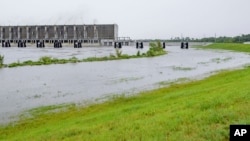A complex and costly flood prevention system helped protect New Orleans when Hurricane Ida hit the Louisiana city last week. Barriers, or seawalls, pumps and other controls blocked major flooding as the sea level rose sharply during the powerful storm.
But something else helped keep the water out of the city: the area’s coastal wetlands. These expanses of earth are covered in shallow water most or all of the time. Many kinds of animals, grasses and other plants make up the ecosystem. The Louisiana wetlands slowed, redirected and helped contain the flow Ida that pushed in from the Gulf of Mexico.
“There is always a benefit by having these wetlands between you and the storm,” said Gerald Galloway. He is a former engineering professor and an expert on flood risks. He has served as an advisor to the U.S. Army Corps of Engineers.
The wetlands had been shrinking for many years in Louisiana. The state launched a major effort to renew the area and barrier islands after the disastrous hurricanes Katrina and Rita of 2005.
How do natural barriers protect against storms?
The plants and uneven ground of wetlands are part of the strong storm resistance the ecosystem provides. These elements slow and weaken the water and winds as the storm moves inland toward people and property.
Hugh J. Roberts is chief operating officer at the Water Institute of the Gulf, an environmental research group. He said wetlands “help with storm protection because they are dissipating energy.” In other words, wetlands help absorb the storm’s energy.
What about big storms like Ida?
Wetlands are generally most effective at lessening the harm from small to moderate surges of ocean water, said Ed Link. He is a researcher at the University of Maryland. He also was the leader of an examination of New Orleans’ storm protections’ after Hurricane Katrina.
With bigger storms like Ida, the protection the wetlands can offer may be more limited. Once the wetlands are full of water, they lose their ability to slow down waves. Storms can more easily travel over them, Link said.
Still, experts say natural barriers offer one more line of defense even with major storms and they can make a difference.
How is the state improving natural defenses?
Louisiana has been spending large amounts of money to restore its natural barriers to help protect against storms. Since 2007, the state has created or restored around 197 square kilometers of marshland and 97 kilometers of barrier island. Marshland is a kind of soft wetland.
The state’s most recent coastal protection and restoration plan includes several projects that build or protect more than 2,072 square kilometers of land. The total cost of such work is estimated to be $50 billion. But the projects are expected to prevent more than $150 billion in damage over the next 50 years.
Is the restoration working?
Even with such efforts, the state’s restoration work cannot keep up with its land losses.
Louisiana has been losing land since at least the 1930s. Flood control measures along the Mississippi River stopped the natural process that left materials from the river in the delta – the low-lying land next to the river. In 2012, state officials predicted their restoration work would someday stop the problem. Five years later, they were no longer making that prediction.
The Louisiana Coastal Protection and Restoration Authority now says the restoration is simply slowing down the land loss.
I’m Ashley Thompson.
The Associated Press reported this story. Ashley Thompson adapted it for VOA Learning English. Caty Weaver was the editor
**The Associated Press receives support from the Walton Family Foundation for coverage of water and environmental policy. The AP is fully responsible for all reporting.
_________________________________________________
Words in This Story
shallow - adj. having a small distance to the bottom from the surface or highest point
absorb - v. to take in (something, such as a liquid) in a natural or gradual way
restore - v. to bring (someone) back to an earlier and better condition; to return (something) to an earlier or original condition by repairing it, cleaning it







